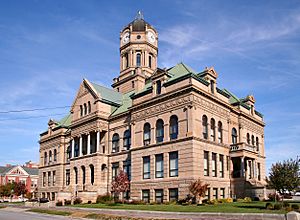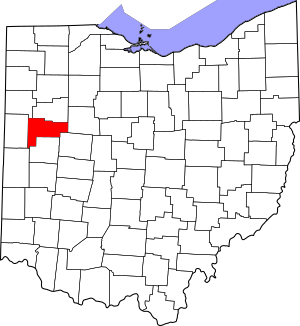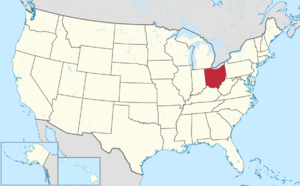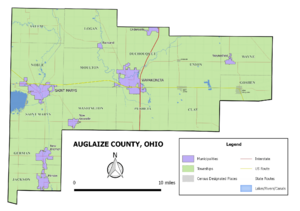Auglaize County, Ohio facts for kids
Quick facts for kids
Auglaize County
|
|||
|---|---|---|---|

County courthouse in Wapakoneta
|
|||
|
|||

Location within the U.S. state of Ohio
|
|||
 Ohio's location within the U.S. |
|||
| Country | |||
| State | |||
| Founded | February 14, 1848 | ||
| Named for | Auglaize River | ||
| Seat | Wapakoneta | ||
| Largest city | Wapakoneta | ||
| Area | |||
| • Total | 402 sq mi (1,040 km2) | ||
| • Land | 401 sq mi (1,040 km2) | ||
| • Water | 0.5 sq mi (1 km2) 0.1%% | ||
| Population
(2020)
|
|||
| • Total | 46,442 | ||
| • Density | 115.53/sq mi (44.61/km2) | ||
| Time zone | UTC−5 (Eastern) | ||
| • Summer (DST) | UTC−4 (EDT) | ||
| Congressional district | 4th | ||
Auglaize County is a county located in Northwestern Ohio, United States. A county is like a smaller region within a state. In 2020, about 46,442 people lived here. The biggest city and the main government center, called the county seat, is Wapakoneta.
Auglaize County is part of the Wapakoneta Micropolitan Statistical Area. This means it's a smaller city area that is also connected to larger areas like Lima.
Contents
What's in a Name? The Story of Auglaize County
The name of Auglaize County comes from the Auglaize River. People have different ideas about what "Auglaize" means.
Some say it comes from old French words. It might mean "clay water" (eau glaise). Others think it comes from a Native American word. This word could mean "fallen timbers" or "overgrown with brush."
Another idea is that French explorers used the word glaise to describe places. These were spots where wild animals would come to lick salt and minerals from the ground. This makes the name mean "at the lick(s)."
Where is Auglaize County?
Auglaize County covers about 402 square miles. Most of this area is land, with only a tiny bit of water. It is the second-smallest county in Ohio by size.
Many important rivers and lakes are found here. The Auglaize River and the Miami and Erie Canal cross through the county. The beginnings of the Saint Marys River, the Great Miami River, and the Scioto River are in Auglaize County. Parts of Grand Lake St. Marys and Lake Loramie are also here.
Neighboring Counties
Auglaize County shares its borders with these other counties:
- Allen County - to the north
- Hardin County - to the east
- Logan County - to the southeast
- Shelby County - to the south
- Mercer County - to the west
- Van Wert County - to the northwest
Who Lives Here? People of Auglaize County
| Historical population | |||
|---|---|---|---|
| Census | Pop. | %± | |
| 1850 | 11,338 | — | |
| 1860 | 17,187 | 51.6% | |
| 1870 | 20,041 | 16.6% | |
| 1880 | 25,444 | 27.0% | |
| 1890 | 28,100 | 10.4% | |
| 1900 | 31,192 | 11.0% | |
| 1910 | 31,246 | 0.2% | |
| 1920 | 29,527 | −5.5% | |
| 1930 | 28,034 | −5.1% | |
| 1940 | 28,037 | 0.0% | |
| 1950 | 30,637 | 9.3% | |
| 1960 | 36,147 | 18.0% | |
| 1970 | 38,602 | 6.8% | |
| 1980 | 42,554 | 10.2% | |
| 1990 | 44,585 | 4.8% | |
| 2000 | 46,611 | 4.5% | |
| 2010 | 45,949 | −1.4% | |
| 2020 | 46,442 | 1.1% | |
| U.S. Decennial Census 1790-1960 1900-1990 1990-2000 2020 |
|||
In 2010, there were about 45,949 people living in Auglaize County. Most people were white (97.8%). A small number of people were Asian, Black, or American Indian. About 1.2% of the population was of Hispanic or Latino background.
Many families in the county have German roots (53%). Other common backgrounds include Irish, American, and English. The average age of people living in Auglaize County was 40 years old.
The average income for a household was about $52,018 per year. For families, it was around $60,318.
How People Make a Living: The Economy
The economy in Auglaize County is mostly based on manufacturing. This means many people work in factories that make different products.
Some of the largest employers in the county include:
- Crown Equipment Corporation
- Joint Township District Memorial Hospital
- The Minster Machine Company
- Setex, Inc.
- AAP-St. Mary's Corporation (part of Hitachi Metals)
- Veyance Technologies, Inc. (part of Goodyear Tire and Rubber Company)
- The Dannon Company
Towns and Villages
Auglaize County has several cities, villages, and smaller communities.
Cities
- Saint Marys
- Wapakoneta (This is the county seat)
Villages
- Buckland
- Cridersville
- Minster (partly in another county)
- New Bremen
- New Knoxville
- Waynesfield
Townships
- Clay
- Duchouquet
- German
- Goshen
- Jackson
- Logan
- Moulton
- Noble
- Pusheta
- Saint Marys
- Salem
- Union
- Washington
- Wayne
Census-designated places
These are special areas that are like towns but are not officially incorporated as cities or villages.
Unincorporated communities
These are smaller places that are not officially part of a city or village.
See also
 In Spanish: Condado de Auglaize para niños
In Spanish: Condado de Auglaize para niños




